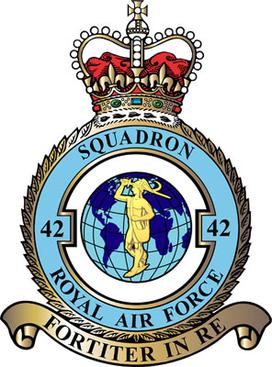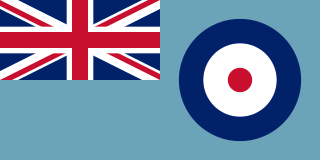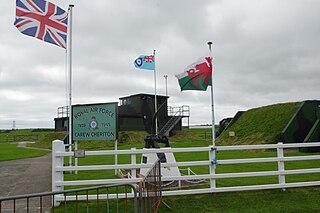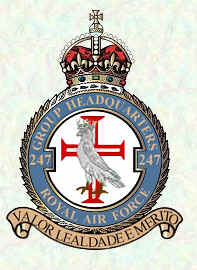
The Avro Shackleton is a British long-range maritime patrol aircraft (MPA) which was used by the Royal Air Force (RAF) and the South African Air Force (SAAF). It was developed by Avro from the Avro Lincoln bomber, which itself had been a development of the famous wartime Avro Lancaster bomber.

The Avro Type 694 Lincoln is a British four-engined heavy bomber, which first flew on 9 June 1944. Developed from the Avro Lancaster, the first Lincoln variants were initially known as the Lancaster IV and V; these were renamed Lincoln I and II. It was the 2nd last piston-engined bomber operated by the Royal Air Force (RAF).

Number 8 Squadron of the Royal Air Force last operated the Boeing E-3D Sentry AEW1 (AWACS) from RAF Waddington, Lincolnshire. As of 2020, the RAF AWACS fleet was made up of three Sentry AEW1s, down from seven originally ordered in the late 1980s. Pursuant to the 2021 defence review, the E-3D Sentry aircraft made its final flight in U.K. service in August 2021.

No. 42 Squadron, also known as No. 42 Squadron or No. 42 (TB) Squadron, is a squadron of the Royal Air Force. It reformed at RAF Lossiemouth on 21 September 2023 as the Operational Conversion Unit for both the Boeing Poseidon MRA1 and Boeing Wedgetail AEW1.

No. 220 Squadron of the Royal Air Force (RAF) was founded in 1918 and disbanded in 1963 after four separate periods of service. The squadron saw service in both the First and Second World Wars, as a maritime patrol unit, and finally as part of Britain's strategic nuclear deterrent.

404 Long Range Patrol and Training Squadron is a long range patrol and training squadron in the Royal Canadian Air Force. The squadron was originally No. 404 Squadron of the Royal Canadian Air Force (RCAF) and later the Canadian Forces Air Command.
No. 203 Squadron RAF was originally formed as No. 3 Squadron Royal Naval Air Service. It was renumbered No. 203 when the Royal Air Force was formed on 1 April 1918.
No. 224 Squadron RAF was a Royal Air Force squadron that saw service in both the First and Second World Wars.
No. 236 Operational Conversion Unit was a Royal Air Force Operational Conversion Unit which was active between 1947 and 1992 and formed by re-numbering and merging different units.
No. 204 Squadron was a Royal Air Force unit first formed in March 1915 as No.4 Squadron Royal Naval Air Service.

No. 18 Group of the Royal Air Force was a group active from 1918 to 1919, and from 1938 to 1996.

Royal Air Force Carew Cheriton, or more simply RAF Carew Cheriton, is a former Royal Air Force station located near Carew, Pembrokeshire. It was situated 4.7 miles (7.6 km) north west of Tenby.
Number 88 Squadron was an aircraft squadron of the Royal Air Force. It was formed at Gosport, Hampshire in July 1917 as a Royal Flying Corps (RFC) squadron.

No. 15 Group was a group of the Royal Air Force, which disbanded in 1945. It was operational in the last year of, and just after, the First World War, a reformation saw it active throughout the Second World War.

No. 16 Group RAF was a group of the Royal Air Force. It existed over two periods in two different roles. No. 16 Group was initially a training group, from 1918 to 1920, that had been transferred from the Royal Flying Corps. It reformed as a reconnaissance group under RAF Coastal Command, in 1936.

No. 17 Group RAF was a group of the Royal Air Force which was operational in the last year of the First World War, and throughout the Second World War.

Air-Sea Warfare Development Unit RAF (ASWDU) was a research and development unit of the Royal Air Force, within RAF Coastal Command, it was operational from December 1940 and disbanded in April 1970.

No. 5 (Coastal) Operational Training Unit RAF, was a training unit of the Royal Air Force, within No. 17 Group RAF, which was part of RAF Coastal Command. The unit was established during August 1941 and disbanded during August 1945.

No. 247 Group was formed in October 1943 within RAF Coastal Command to control units operating from the Azores. It disbanded in March 1946.










